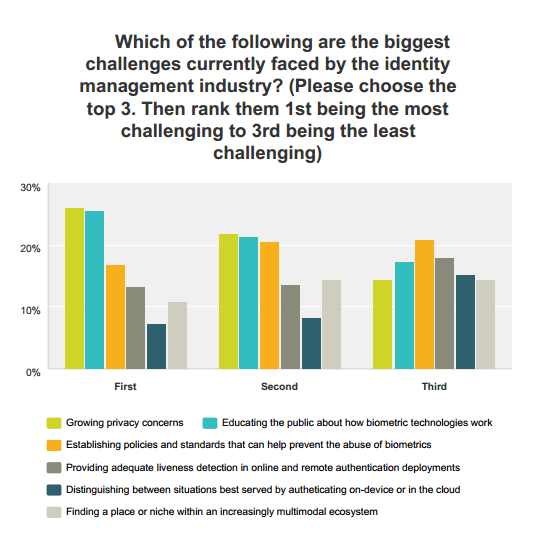Tweet: Have you seen the #NewFindBiometrics ? The site that you depend on for all your #biometric news has a fresh new look! Check it out now http://ctt.ec/vKauZ+ #Biometrics
Throughout January at FindBiometrics, we are dissecting the results of our 12th annual industry Year in Review survey. The data, gathered from over 150 professionals and identity experts, is intended to present how the identity management industry saw the previous year and what we should all be keeping in mind as time marches on.
Last week we looked at the vertical markets that our experts are most excited about heading into 2015, and the week before that we examined the hottest areas in biometrics for 2014. Now we will be focusing on the present by trying to understand what the greatest challenges are for the identity management industry.

Privacy Concerns
As connectivity continues to grow and users find their online identities fractured between increasingly numerous public and private accounts, each one demanding different permissions on collecting and sharing personal data, it is no wonder that privacy is being pushed to the front of everyone’s mind. Biometric technology is not an exempt topic in this critical discussion, and unfortunately said topic is filled with friction.
Whether it involved the controversial application of facial recognition and mobile tech, like the Google Glass app that moved Senator Al Franken to write a letter to Facial Network, or it resulted in the banning of biometrics in schools, conversations about privacy and biometrics in 2014 were dramatic to say the least.
Moving forward, it is absolutely in the industry’s best interest to keep the privacy discussion moving, lest panic take hold and hamper the public’s willingness to adopt the strong authentication methods necessary to move beyond passwords and PINs.
FindBiometrics helped facilitate this challenging dialogue twice in 2014, with our privacy webinar featuring a dialogue between representatives from the IBIA and the ACLU and at Biometrics UnPlugged where we bought advocacy groups and academics concerned with privacy into conversation with the biometrics industry’s brightest minds.
Addressing the growing privacy concerns surrounding biometrics is still a major challenge as we continue into 2015. In a recent interview with FindBiometrics, Samsung’s Steven Rahman suggested that the solution to the privacy problem might rest in the design process.
“[Privacy] should be brought into the actual designs when we are creating devices,” said Rahman. “For example, I’m just going to throw out an idea for a product which I will call a wearable baseball hat where it would contain a huge amount of relevant information about a sports game you are watching. So if someone were to design such a hat, instead of saying: “We have finished the design on this product, let’s now address privacy and attach privacy enhancing technologies to this thing,” why not start the design process with a set of requirements related to privacy from the very beginning?”
It’s What You Know
Just barely coming in second place for biggest industry challenge is educating the public about how biometric technologies work. It makes sense that this obstacle would be neck and neck with privacy for the top spot, since many false privacy concerns are born from a lack of education on the ins-and-outs of biometrics.
For many in the identity management industry, it is baffling that the suggestion of passwords being superior to biometric factors is still an assertion treated by many with legitimacy, yet said claims are still made. While skepticism and criticism is part of a healthy dialogue in any industry, when the contrary opinion is coming from a place of very little understanding of the subject, no one wins.
The easiest example from 2014 of the lack of education on biometrics leading to negative industry consequences comes from the passing of Florida Senate Bill 188 which banned the collection of student biometrics throughout the state. The IBIA’s Walter Hamilton told FindBiometrics that this was a case of “technopanic” that grew out of overreaction and misunderstanding in regards to how biometric technology was being used, what it could be used for, how it was stored and what could potentially happen when it was compromised.
Much like the privacy debates, educating the public on the use of biometrics is a very pressing issue as we enter 2015. Biometric technology is being built into consumer devices at an unprecedented level, and as the public begins to encounter this new technology it is important that they understand basic security and identity principles.
Getting on the Same Page
The third most pressing challenge as voted on by our biometric experts has to do with protecting the public, and hopefully as this concern is addressed it will go a long way in helping the industry overcome the top two picks in this category. Establishing policies and standards that can help prevent the abuse of biometric technology will open up a lot of freedom in terms of applying biometrics to emerging technologies like the Internet of Things, connected cars, marketing, and fraud protection.
Following up in fourth place is the challenge of providing adequate liveness detection in online and remote authentication situations. Aside from scalability (and in the case of EyeVerify: the ability to reset an enrollment), liveness detection is a huge tool in the fight for biometrics to replace passwords. With high profile public spoofing demonstrations still taking place, continuing to develop technology that can directly combat hackers’ break-in attempts is important for the everyday biometrics user’s peace of mind if nothing else. Of course, as multi-factor solutions become more accessible, the need for liveness detection is less urgent than one might expect, though it will always be part of a healthy strong authentication ecosystem.
*
Stay posted to FindBiometrics next week as we finish unpacking the 12th annual Year in Review. Have something to add to the conversation? Follow us on Twitter and tweet using the hashtag #FBYearInReview.
—
January 21, 2015 – by Peter B. Counter


Follow Us